Extra Questions for Class 10 Maths Probability with Answers
Extra Questions for Class 10 Maths Chapter 15 Probability. According to new CBSE Exam Pattern, MCQ Questions for Class 10 Maths Carries 20 Marks.
You can also download Class 10 Maths NCERT Solutions to help you to revise complete syllabus and score more marks in your examinations.
Probability Class 10 Extra Questions Very Short Answer Type
Question 1.
A number is chosen at random from the numbers -3, -2, -1,0,1,2,3. What will be the probability that square of this number is less than or equal to 1 ? [CBSE Delhi 2017]
Answer:
Here total outcomes = 7, favourable outcomes are -1, 0, 1
Reqd. probability = \(\frac{\text { No. of favourable outcomes }}{\text { Total no. of outcomes }}=\frac{3}{7}\)
Question 2.
The probability that it will rain today is 0.75. /£) What is the probability that it will not rain today?
Answer:
P(rain today) = 0.75
P(not rain today) = 1 – P(rain today)
= 1 – 0.75
= 0.25
Question 3.
The probability of getting a bad egg in a lot of 500 eggs is 0.028. Find the number of good eggs in the lot.
Answer:
Total eggs = 500
Let no. of bad eggs = x
P(bad eggs) = \(\frac{x}{500}\)
0.028 = \(\frac{x}{500}\) ⇒ x = 14
Number of good eggs = 500 – 14
= 486
Hence, number of good eggs is 486.
Question 4.
A card is selected at random from a deck of 52 cards. Find the probability that the selected card is red face card.
Answer:
Total cards = 52
Red face cards = 6
P(a red face card) = \(\frac{6}{52}=\frac{3}{26}\)
Question 5.
A card is drawn at random from a well shuffled pack of 52 playing cards. Find the probability of getting neither a red card nor a queen.
[CBSE Outside Delhi 2016]
Answer:
Let E be the event of getting neither red card nor queen
No. of red cards = 26 (including 2 queens)
Remaining (black) queens = 2
Neither red nor queen
= 52 – (26 + 2) = 52 – 28 = 24 24 6
P(E) = \(\frac{24}{52}=\frac{6}{13}\)
Question 6.
Cards marked with number 3,4,5……………. ,50 are placed in a box and mixed thoroughly. A card is drawn at random from the box. Find the probability that the selected card bears a perfect square number. [CBSE 2016]
Answer:
It is given that the box contains cards marked with numbers 3,4,5, ………… , 50.
∴ Total number of outcomes 48
There are six perfect squares, i.e., 4, 9, 16, 25, 36 and 49.
∴ Number of favourable outcomes = 6
Probability that a card drawn at random bears a perfect square
= \(\frac{\text { Number of favourable outcomes }}{\text { Total number of outcomes }}=\frac{6}{48}=\frac{1}{8}\)
Question 7.
What is the probability that a doublet occurs on throwing two dice?
Answer:
Total outcomes = 36
Doublets = 6
{(1, 1) (2, 2) (3, 3) (4, 4) (5, 5) (6, 6)}
P(a doublets) = \(\frac{6}{36}=\frac{1}{6}\)
Question 8.
In a throw of a coin, find the probability of getting a head.
Answer:
Here, S = {H, T} and E = {H}
∴ P(E) = \(\frac{n(\mathrm{E})}{n(\mathrm{~S})}=\frac{1}{2}\)
Question 9.
Two unbiased coins are tossed. What is the probability of getting at most one head?
Answer:
Here, S = {HH, HT, TH, TT).
Let E = event of getting at most one head.
∴ E = {TT, HT, TH}.
∴ P(E) = \(\frac{n(\mathrm{E})}{n(\mathrm{~S})}=\frac{3}{4}\)
Question 10.
An unbiased die is tossed. Find the probability of getting a multiple of 3?
Answer:
Here, S = {1, 2, 3, 4, 5, 6}
Then, E = {3, 6}
∴ P(E) = \(\frac{n(\mathrm{E})}{n(\mathrm{~S})}=\frac{2}{6}=\frac{1}{3}\)
Question 11.
In a well shuffled pack of cards, a card is © drawn at random. Find the probability of getting a black queen.
Answer:
Total cards = 52
Total no. of black queens = 2
∴ P(a black queen) = \(\frac{2}{52}=\frac{1}{26}\)
Question 12.
Two coins are tossed simultaneously. What is the probability of getting exactly one ‘. head?
Answer:
Here, sample space S = {HH, HT, TH, TT}
∴ n(S) = 4
and E = {HT, TH}
∴ n(E) = 2
∴ Reqd. Prob. = P(E) = \(\frac{2}{4}=\frac{1}{2}\)
Question 13.
In a lottery there are 13 prizes and 117 blanks. What is the probability of not winning a prize?
Answer:
No. of ways of not winning a prize
= No. of blanks = 117
Total cases = 13 + 117 = 130
P(not winning) = \(\frac{117}{130}=\frac{9}{10}\)
Question 14.
What is the probability of getting “a black¬face card’ from a well shuffled deck of 52 playing cards?
Answer:
There are 6 black face cards.
(2 red kings, 2 red queens and 2 jacks)
Total cards = 52
∴ Required Probability = \(\frac{6}{52}=\frac{3}{26}\)
Question 15.
Out of 400 bulbs in a box, 15 bulbs are defective. One bulb is taken out at random from the box. Find the probability that the bulb drawn is non-defective.
Answer:
No. of non-defective bulbs = 400 – 15 = 385
Total bulbs = 400
∴ P(a non-defective bulb) = \(\frac{385}{400}=\frac{77}{80}\)
Question 16.
If you toss a coin 6 times and it comes down heads on each occasion. Can you say that the probability of getting a head is 1? Give reasons.
Answer:
No, the outcomes ‘head’ and ‘tail’ are equally likely every time regardless of what you get in a few tosses.
Probability Class 10 Extra Questions Short Answer Type-1
Question 1.
Jayanti throws a pair of dice and records the product of the numbers appearing on the dice. Pihu throws 1 dice and records the square of the number that appears on it. Who has the better chance of getting 36? Justify
Or
An integer is chosen between 70 and 100. Find the probability that it is (i) a prime number (ii) divisible by 7. [CBSE SQP 2019-20 (Standard)]
Answer:
For Jayanti: n (S) = 36
Favourable outcome for getting product 36 is 6 on both dice which is (6,6) just one
∴ P (Jayanti getting 36) = \(\frac{1}{6}\)
For Pihu:
Total number of outcomes = 6
Favourable outcome is 6 i.e., 1.
Probability (getting the number 36) = \(\frac{1}{6}\)
∵ \(\frac{1}{6}>\frac{1}{36}\)
Pihu has the better chance.
Or
Total number of possible outcomes = Number of integers between 70 and 100 = 29
(i) Prime numbers between 70 and 100 are 71, 73, 79, 83, 89, 97 i.e., 6 in all.
∴ P (Prime number) = \(\frac{6}{29}\)
(ii) Numbers lying between 70 and 100 and divisible by 7 are 77,84, 91,98 i.e., 4 in all.
∴ P(Divisible by 7) = \(\frac{4}{29}\)
Question 2.
A game consists of tossing a coin 3 times and noting the outcome each time. If getting the same result in all the tosses is a success, find the probability of lossing the game. [CBSE 2019]
Answer:
Here, sample space S = {HHH, HHT, HTH, THH, TTH, THT, HTT, TTT}
Total number of outcomes n(S) = 8
If E be the given event of success then E = {HHH, TTT}
Total number of favourable outcomes, n(E) = 2
P (Losing the game) = 1 – P (Success)
= 1 – \(\frac{n(\mathrm{E})}{n(\mathrm{~S})}\)
= 1 – \(\frac{2}{8}\) = 1 – \(\frac{1}{4}=\frac{3}{4}\)
Question 3.
A die is thrown once. Find the probability of getting a number which (i) is a prime number (ii) lies between 2 and 6. [CBSE 2019]
Answer:
(i) Here, total number of outcomes, n (S) = 6
Let E be the event of getting prime number, then E = {2,3,5}
Total number of favourable outcomes, n(E) = 3
(ii) Let F be the event of getting a number between 2 and 6.
Then, F = {3, 4, 5}
⇒ Total number of favourable outcomes n(F) = 3
∴ P(F) = \(\frac{n(\mathrm{~F})}{n(\mathrm{~S})}=\frac{3}{6}=\frac{1}{2}\)
Question 4.
A pair of dice is thrown once. Find the probability of getting (i) even number on each dice (») a total of 9. [CBSE 2019 (c)]
Answer:
Here, n(S) = 36
Let E1 be event of getting even number on each dice.
∴ E1 ={(2, 2), (2, 4), (2, 6), (4, 2), (4, 4), (4, 6), (6, 2), (6, 4), (6, 6)}
∴ n(E1) = 9
∴ P(even number on each die)
P(E1) = \(\frac{n\left(\mathrm{E}_1\right)}{n(\mathrm{~S})}\)
= \(\frac{9}{36}=\frac{1}{4}\)
(ii) Let E2 be the event of getting a total of 9.
∴ E2 = {(3,6), (4,5), (5,4), (6,3)},
∴ P(E2) = 4
∴ P(a total of 9) = P(E2)
= \(\frac{n\left(\mathrm{E}_2\right)}{n(\mathrm{~S})}=\frac{4}{36}=\frac{1}{9}\)
Question 5.
A bag contains some balls of which x are white, 2x are black and 3x are red. A ball is selected at random. What is the probability that it is (i) not red (it) white? [CBSE 2019 (C)]
Answer:
Total no. of balls = x + 2x + 3x
= 6x
(i) P(not red) = 1 – P(red)
= 1 – \(\frac{\text { No. of red balls }}{\text { Total no. of balls }}\)
= 1 – \(\frac{3 x}{6 x}\)
= 1 – \(\frac{1}{2}=\frac{1}{2}\)
(ii) P(white) = \(\frac{\text { No. of white balls }}{\text { Total no. of balls }}\)
= \(\frac{x}{6 x}\)
= \(\frac{1}{6}\)
Question 6.
In a simultaneous throw of a pair of dice, find the probability of getting a total more than 7.
Answer:
Here, n (S) = (6 x 6) = 36.
Let E = Event of getting a total more than 7
= {(2, 6), (3, 5), (3, 6), (4, 4), (4, 5), (4, 6), (5, 3), (5, 4), (5, 5), (5, 6), (6, 2), (6, 3), (6, 4), (6, 5), (6, 6)}
∴ P(E) = \(\frac{n(\mathrm{E})}{n(\mathrm{~S})}=\frac{15}{36}=\frac{5}{12}\)
Question 7.
A bag contains 6 white and 4 black balls. Two balls are drawn at random. Find the probability that they are of the same colour.
Answer:
Let S be the sample space. Then
n (S) = Number of ways of drawing 2 balls out of (6 + 4)
= 10C2 = \(\frac{10 !}{2 !(10-2) !}=\frac{10 \times 9 \times 8 !}{2 \times 8 !}\) = 45
Let E = Event of getting both balls of the same colour. Then
n(E) = Number of ways of drawing 2 balls out of 4
= (6C2 + 4C2) = \(\frac{(6 \times 5)}{(2 \times 1)}+\frac{(4 \times 3)}{(2 \times 1)}\)
= (15 + 6) = 21
∴ P(E) = \(\frac{n(\mathrm{E})}{n(\mathrm{~S})}=\frac{21}{45}=\frac{7}{15}\)
Question 8.
Two friends were born in the year 2000. What is the probability that they have the same birthday?
Answer:
There are 366 days in 2000 (leap year)
Total no. of ways in which both friends can have their birthday = 366 × 366
No. of ways in which they have different birthdays = 366 × 365
∴ P(different birthday) = \(\frac{366 \times 365}{366 \times 366}=\frac{365}{366}\)
⇒ P(same birthday) = 1 – P(different birthdays)
= 1 – \(\frac{365}{366}=\frac{1}{366}\)
Question 9.
A die is thrown once. Find the probability of getting (i) a prime number (ii) a number lying between 2 and 6 (iii) an odd number.
Answer:
Total possible outcomes in throwing a single die are 1, 2, 3,4, 5, 6; which are six in number,
(i) Outcomes favouring a prime number among these six outcomes are 2,3,5 So, number of outcomes favouring a prime number = 3
∴ p(a prime number) = \(\frac{\text { Number of outcomes favouring a prime number }}{\text { Total number of possible outcomes }}\)
= \(\frac{3}{6}=\frac{1}{2}\)
(ii) Since numbers lying between 2 and 6 are 3,4,5
So, number of outcomes favouring an outcome between 2 and 6 = 3
∴ P(a number lying between 2 and 6) = \(\frac{3}{6}=\frac{1}{2}\)
(iii) Since odd numbers on a die are 1,3,5
So, number of outcomes favouring an odd number = 3
∴ P(an odd number) = \(\frac{3}{6}=\frac{1}{2}\)
Question 10.
A box contains cards numbered 11 to 123. A card is drawn at random from the box. Find the probability that the number on the drawn card is:
(i) a square number
(ii) a multiple of 7 [CBSE Sample Paper-2017]
Answer:
Here n(s) = (123 – 10) = 113
Square numbers are E1 = {16, 25, 36, 49, 64, 81, 100, 121}
n(E1) = 8
∴ (i) p( a square number) = \(\frac{n\left(\mathrm{E}_{1)}\right.}{n(\mathrm{~s})}=\frac{18}{113}\)
Multiple of 7 are E2 = {14, 21, 28, 35, 42, 49, 56, 63, 70, 77, 84, 91, 98, 105, 112, 119}
n(E2) = 16
(ii) P(a multiple of 7) = \(\frac{n\left(\mathrm{E}_2\right)}{n(s)}=\frac{16}{113}\)
Question 11.
Cards, marked with numbers 5 to 50, are placed in a box and mixed thoroughly. A card is drawn from the box at random. Find the probability that the number on the taken out card is
(i) a prime number less than 10.
(ii) a number which is a perfect square.
Answer:
S = {5, 6, 7,…, 50}
⇒ n(S) = 46
(i) Prime number less than 10 are 5,7 i.e. two
∴ P(prime number less than 10) = \(\frac{2}{46}=\frac{1}{23}\)
(ii) Perfect square numbers are 9, 16, 25, 36, 49, i.e. five
∴ P(a perfect square) = \(\frac{5}{46}\)
Question 12.
A bag contains 14 balls of which x are white. If 6 more white balls are added to the bag, the probability of drawing a white ball is \(\frac{1}{2}\). Find the value of x.
Answer:
Total no. of balls = 14, out of which x are white balls, 6 more white balls are added then white balls = x + 6
P(a white ball) = \(\frac{x+6}{20}=\frac{1}{2}\)
∴ x = 4
Question 13.
A box contains 12 balls of which some are red in colour. If 6 more red balls are put in the box and a ball is drawn at random, the probability of drawing a red ball doubles than what it was before. Find the number of red balls in the bag.
Answer:
Let there be ‘x’ no. of red balls in the box originally
∴ P(red ball) = \(\frac{x}{12}\)
After adding 6 red balls
P(red ball) = \(\frac{x+6}{12+6}=\frac{x+6}{18}\)
It is given that

⇒ \(\frac{x+6}{3}\) = x
⇒ x + 6 = 3x
⇒ 2x = 6
⇒ x = 3
∴ There are 3 red balls in the beg.
Question 14.
Two players, Sangeeta and Reshma play a tennis match. It is known that the probability of Sangeeta winning the match is 0.62. What is the probability of Reshma winning?
Answer:
We denote the event ‘Reshma wins the tennis match’ by R. We are given that P(S) = 0.62. Now, the event S and R are complementary because at a time only one can happen. i.e. ‘not S’ means the event R and ‘not R’ means the event S.
⇒ P(S) + P(R) = 1
⇒ 0.62 + P(R) = 1
⇒ P(R) = 1 – 0.62 = 0.38
Question 15.
Two different dice are tossed together. Find the probability:
(i) of getting a doublet
(ii) of getting a sum 10, of the numbers on the two dice. [CBSE 2018]
Answer:
Total number of possible outcomes = 36
(i) Doublets are (1,1) (2, 2) (3, 3) (4,4) (5,5) (6,6)
Total number of doublets = 6
∴ Prob (getting a doublet) = \(\frac{6}{36}=\frac{1}{6}\)
(ii) Favourable outcomes for getting sum 10 are (4, 6) (5, 5) (6, 4) i.e., 3
∴ Prob (getting a sum) 10 = \(\frac{3}{36}=\frac{1}{12}\)
Question 16.
An integer is chosen at random between 1 and 100. Find the probability that it is :
(i) divisible by 8
(ii) not divisible by 8. [CBSE 2018]
Answer:
Total number of outcomes = 98
(i) Favourable outcomes are 8,16,24,…, 96 i.e., 12
∴ Prob (integer is divisible by 8) = \(\frac{12}{98}=\frac{6}{49}\)
(ii) Prob (integer is not divisible by 8) = 1 – \(\frac{6}{49}\)
= \(\frac{43}{49}\)
Probability Class 10 Extra Questions Short Answer Type-2
Question 1.
Two different dice are thrown together. Find the probability that the number obtained.
(i) have a sum less than 7
(ii) have a product less than 16
(iii) is a doublet of odd numbers. [CBSE 2017]
Answer:
Total number of outcomes = 36
(i) Favourable outcomes are
(1,1) (1,2) (1,3) (1,4) (1,5) (2,1) (2,2) (2,3) (2,4) (3,1) (3,2) (3,3) (4,1) (4,2) (5,1)
no. of favourable outcomes = 15
∴ P(sum lesfe than 7) = \(\frac{15}{36}=\frac{5}{12}\)
(ii) Favourable outcomes are
(1.1) (1,2) (1,3) (1,4) (1,5) (1,6) (2,1) (2,2) (2,3) (2,4) (2,5) (2,6) (3,1) (3,2) (3,3) (3,4) (3,5) (4,1) (4,2) (4,3) (5,1) (5,2) (5,3) (6,1)
(6.2)
no. of favourable outcomes = 25
∴ P(product less than 16) = \(\frac{25}{36}\)
(iii) Favourable outcomes are
∴ P(doublet of odd number) = \(\frac{3}{36}=\frac{1}{12}\)
Question 2.
In a single throw of a pair of different dice, what is the probability of getting (?) a prime number on each dice? (it) a total of 9 or 11? [CBSE 2016]
Answer:
Total number of outcomes on throwing a pair of dice = 6 x 6 = 36
(i) Let E be the event of getting a prime number on each dice.
∴ Favourable outcomes = {(2, 2), (2, 3), (2, 5), (3,2), (3,3), (3,5), (5,2), (5,3), (5,5)}
Number of favourable outcomes = 9
Now, P(E) = \(\frac{9}{36}=\frac{1}{4}\)
Thus, the probability of getting a prime number 1 on each dice is \(\frac{1}{4}\)
(ii) Let F be the event of getting a total of 9 or 11.
∴ Favourable outcomes = {(3, 6), (4, 5), (5, 4), (6,3), (5,6), (6,5)}.
Number of favourable outcomes = 6
Now,
P(F) = \(\frac{6}{36}=\frac{1}{6}\)
Thus, the probability of getting a total of 9 or 11 is \(\frac{1}{6}\)
Question 3.
Three different coins are tossed together. Find the probability of getting (i) exactly two heads (it) at least two heads (iii) at least two tails. [CBSE Outside Delhi 2016]
Answer:
Here sample space S
= {HHH, HHT, HTH, THH, HTT, THT, TTH, TTT}
⇒ n(s) = 8
(i) Now, P (exactly two heads)
= P ({TTH, THT, HTT, TTT}) = \(\frac{3}{8}\)
(ii) P(at least two heads)
= P({HHT, HTH, THH, HHH}) = \(\frac{4}{8}=\frac{1}{2}\)
(iii) P(at least two tails)
= P({TTH, THT, HTT, TTT}) = \(\frac{4}{8}\)
Question 4.
From the group of 2 boys and 3 girls, two children are selected at random. Find the probability:
(i) both selected children are girls.
(ii) the selected group consists of one boy and one girl.
(iii) at least one boy is selected.
Answer:
Let B1, B2 be two boys and G1, G2, G3 be three girls. So, the sample space is given by

∴ Total possible outcomes = 10
(i) P (both girls) = P(G1G2, G1G3, G2G3) = \(\frac{3}{10}\)
(ii) P(one boy and one girl) = P(B1G1, B1G2, BA, B2G2, B2G3) = \(\frac{6}{10}=\frac{3}{5}\)
(iii) P (at least one boy is selected)
= P(one boy or both boys)
= P(B1G1, B1G2, B2G3, B2G1, B2G2, B2G3, B3B2)
= \(\frac{7}{10}\)
Question 5.
A card is drawn at random from a well shuffled deck of playing cards. Find the 1 probability of drawing a (>) face card (ii) card which is neiher a king nor a red card.
Answer:
(i) There are 12 face cards
∴ P(face card) = \(\frac{12}{52}=\frac{3}{13}\)
(ii) P(neither a king nor a red card)
= 1 – P (red and king)
= 1 – \(\frac{28}{52}\)
[as there are 26 red cards including 2 red kings and 2 black kings]
= 1 – \(\frac{7}{13}=\frac{6}{13}\)
Question 6.
A number ‘a’ is selected from the number [2,3] and then a second number V is selected from [1, 3, 7]. What is the probability that the product ab of two numbers is greater than 9?
Answer:
Number ‘a’ can be selected in two ways and corresponding to each such way there are three ways of selecting number ‘b’.
Threrefore, two numbers can be selected in 2×3 = 6 ways as listed below:
(2,1), (2, 3), (2, 7), (3,1), (3, 3), (3, 7)
∴ n(S) = 6
The product ab is greater than 9 if a and b are chosen in any one of following ways (2, 7), (3, 7)
∴ Favourable cases = 2
∴ Required probability = \(\frac{2}{6}=\frac{1}{3}\)
Question 7.
The king, queen and jack of clubs are removed from a deck of 52 playing cards and then well shuffled. Now one card is drawn at random from the remaining cards. Determine the probability that the card is;
(i) a heart (ii) a king.
Answer:
After removal of three cards (king of clubs, queen of clubs and jack of clubs) we are left with 52 – 3 = 49 cards.
Well shuffling of these left over 49 cards ensure equally likely outcomes i.e., each of the 49 cards are equally likely to be drawn.
∴ Total number of possible outcomes = 49
(i) Let ‘E1‘ be the event of getting a heart.
Since all the 13 cards of heart are intact among 49 cards.
∴ Number of outcomes favourable to E1 = 13
⇒ P(a heart) = P(E1)
(ii) Let ‘E2‘ be the event of getting a king.
Since there are 4 kings out of which king of clubs is removed.
∴ Number of king among left over 49 cards = 3
⇒ Number of outcomes favourable to E2 = 3
∴ P(a king) = P(E3)
= \(=\frac{\text { Number of outcomes favourable to the event } \mathrm{E}_2}{\text { Total number of possible outcomes }}\)
= \(\frac{3}{49}\)
Probability Class 10 Extra Questions Long Answer Type 1
Question 1.
Peter throws two different dice together and find the product of the two numbers obtained. Rina throws a die and squares the number obtained. Who has the better chance to get the number 25. [CBSE Delhi 2017]
Answer:
For Peter,
Total number of outcomes = 36
Favourable outcome is (5,5) i.e. 1 out of 36
∴ P(Peter getting the number 25) = \(\frac{1}{6}\)
For Rina, total number of outcomes = 6
Favourable outcome is 5. i.e. 1 out of 6
∴ P(Rina getting the number 25) = \(\frac{1}{6}\)
Rina has the better chance.
Question 2.
A game of chance consists of spinning an arrow on a circular board, divided into 8 equal parts, which comes to rest pointing at one of the numbers 1, 2, 3, …., 8 (figure) which are equally likely outcomes. What is the probability that the arrow will point at (i) an odd number (ii) a number greater than 3 (iii’) a number less than 9. [CBSE Delhi 2016]
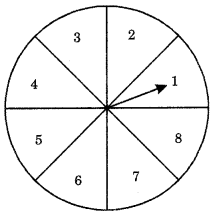
Answer:
Arrow can come to rest at any of the numbers 1,2,3,4,5, 6, 7 and 8.
Total number of events = 8
(i) There are four odd numbers 1, 3, 5 and 7.
Probability that the arrow will point at an odd number is given by
P (Arrow point at odd number) = \(\frac{4}{8}\) = \(\frac{1}{2}\)
(ii) There are five numbers greater than 3, that is 4, 5, 6, 7 and 8.
Probability that the arrow will point at a number greater than 3 is given by
P (Arrow point at a number greater than 3) = \(\frac{5}{8}\)
(iii) All the numbers are less than 9
Probability that the arrow will point at a number less than 9 is given by
P (Arrow point at a number less than 9) = \(\frac{8}{8}\) = 1
Question 3.
A number x is selected at random from the numbers 1, 2, 3 and 4. Another number y is selected at random from the numbers 1, 4, 9 and 16. Find the probability that product of x and y is less than 16. [CBSE Outside Delhi 2016]
Answer:
S = {(1,1) (1, 4) (1, 9) (1,16) (2,1) (2, 4) (2, 9), (2,16), (3,1) (3,4), (3,9), (3,16), (4,1), (4,4), (4,9),(4,16)}
⇒ n(S) = 16
Let E1 be event that xy < 16
∴ E1 = {(1,1); (1,4); (1,9); (2,1); (2,4), (3,1), (3,4), (4,1)}
⇒ n(E1) = 8
Question 4.
(i) Two dice are rolled once. Find the probability of getting such numbers on the two dice, whose product is 12.
(ii) A box contains 80 discs which are numbered from 1 to 80. If one disc is drawn at random from the box, find the probability that it bears a perfect square number.
Answer:
(i) Elementary space of two dice thrown.
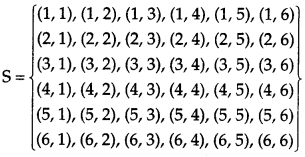
∴ Number of total outcomes = 36
Favourable outcomes are those whose product is 12.
Such outcomes are (2,6) (3,4) (4,3) (6,2)
Number of favourable outcomes = 4
P(numbers on the dice whose product is 12) = \(\frac{4}{36}=\frac{1}{9}\)
(ii) Possible outcomes are 1, 2, 3, ………….. ,80
Total number of favourable outcomes = 80
Now favourable outcomes are “perfect square”.
Such outcomes are 1, 4, 9, 16, 25, 36, 49, 64.
Number of favourable outcomes = 8
Hence, P(a perfect square number) = \(\frac{8}{80}=\frac{1}{10}\)
Question 5.
A box contains 20 balls bearing numbers 1, 2, 3, 4, 5, ………, 18, 19, 20. A ball is drawn at random from the box. What is the probability that the number on the ball is:
(i) an odd number?
(ii) divisible by 2 or 3?
(iii) prime number?
(iv) not divisible by 10?
Answer:
Since balls are marked as 1, 2, 3, 4, 5, 6, ………. , 17, 18,19, 20.
∴ Total number of balls = 20, random drawing of balls ensures equally likely outcomes.
⇒ Total number of possible outcomes = 20
(i) Let E denotes the event of drawing an odd number.
The number of outcomes favourable to the event E = 10
[∵ 1,3, 5,7,9,11,13,15,17,19 are odd numbers from 1 to 20]
P(an odd number) = P(E)
= \(\frac{\text { Number of outcomes favourable to the event } \mathrm{E}}{\text { Total number of possible outcomes }}\)
= \(\frac{10}{20}=\frac{1}{2}\)
(ii) Let F denotes the event of drawing a ball divisible by 2 or 3.
Since, there are 13 balls: 2,3,4,6,8,9,10,12,14, 15,16,18,20 which are divisible by 2 or 3.
Number of outcomes favourable to the event F = 13.
P(a number divisible by 2 or 3) = P(F)
= \(\frac{\text { Number of outcomes favourable to the event } F}{\text { Total number of possible outcomes }}\)
= \(\frac{13}{20}\)
(iii) Let ‘G’ denotes the event of drawing a ball which is a prime number.
There are 8 balls: 2, 3, 5, 7,11,13,17,19 which are prime.
Number of outcomes favourable to the event G = 8
P(a prime number) = P(G)
= \(\frac{\text { Number of outcomes favourable to the event } G}{\text { Total number of possible outcomes }}\)
= \(\frac{8}{20}=\frac{2}{5}\)
(iv) Let ‘H’ denote the event of drawing a ball divisible by 10
There are 2 balls: 10,20, which are divisible by 10.
Number of outcomes favourable to the event H = 2.
P(a number divisible by 10) = P(H)
= \(\frac{\text { Number of outcomes favourable to the event } \mathrm{H}}{\text { Total number of possible outcomes }}\)
= \(\frac{2}{20}=\frac{1}{10}\)
P(number not divisible by 10)
= 1 – P(a number divisible by 10) [VP(E) = 1-P(E)1
= 1 – P(H) = 1 – \(\frac{1}{10}=\frac{9}{10}\)
Probability Class 10 Extra Questions HOTS
Question 1.
If 65% of the population of a town have black eyes, 25% have brown eyes and the remaining have blue eyes. What is the probability that a person selected at random has (i) Blue eyes (ii) Brown or black eyes (Hi) Blue or black eyes (iv) Neither blue nor brown eyes.
Answer:
Assuming there are 100 pairs of eyes
we have: Number of pairs of black eyes = 65
Number of pairs of brown eyes = 25
Number of pairs of blue eyes = 10
(i) P(blue eyes)
= \(\frac{\text { Number of pairs of blue eyes }}{\text { Total pairs of eyes }}=\frac{10}{100}=\frac{1}{10}\)
(ii) P(brown or black eyes)
= \(\frac{\text { Number of pairs of brown or black eyes }}{\text { Total pairs of eyes }}\)
= \(\frac{25+65}{100}=\frac{90}{100}=\frac{9}{10}\)
(iii) P(blue or black eyes)
= \(\frac{\text { Number of pairs of blue or black eyes }}{\text { Total pairs of eyes }}\)
= \(\frac{65+10}{100}=\frac{75}{100}=\frac{3}{4}\)
(iv) P(neither blue nor brown eyes) .
= 1 – P (either blue or brown eyes)
= 1 – \(\frac{\text { Number of pairs of blue or brown eyes }}{\text { Total pairs of eyes }}\)
= 1 – \(\left(\frac{25+10}{100}\right)\)
= 1 – \(\frac{35}{100}=\frac{65}{100}=\frac{13}{20}\)
Question 2.
A bag contains only red, blue and green balls. Probability of selecting a red ball is \(\frac{1}{3}\). Probability of selecting a green ball is \(\frac{1}{6}\). If the bag contains 24 blue balls, what is the total number of the balls in the bag?
Answer:
Let the total number of balls be x
As number of blue balls = 24
P(a blue ball) = \(\frac{24}{x}\)
We know that the sum of the probabilities of all elementary events at a random experiment is 1.
⇒ P(red ball) + P(blue ball) + P(green ball) = 1 1 24 1
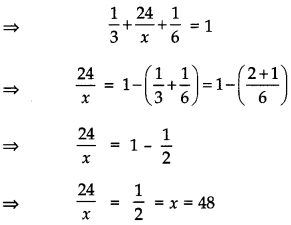
Hence, total number of balls in the bag is 48.
Question 3.
Find the probability that all three children in a family have different birthdays.
(Take 1 year = 365 days).
Answer:
The first child may be bom on any of the 365 days of the year. Similarly, the second as well as the third one may also be bom on any of the 365 days of respective year of birth. Thus, the total number of possible ways in which the three children have birthdays is 365 * 365 * 365.
These cases are mutually exclusive, exhaustive and equally likely. Thus, total number of cases = 365 × 365 × 365.
For the number of favourable cases, we note that the first child may have any one of the 365 days of the year as its birthday. In order that the second child has a birthday different from that of the first, it should have been bom on any one of the 364 remaining days of the year. Similarly, the third one should have been bom on any one of the remaining 363 days of the year. So the number of cases favourable to the event ‘different birthdays’ is clearly [365 × 364 × 363.]
∴ Required probability
= \(\frac{365 \times 364 \times 363}{365 \times 365 \times 365}=\frac{132132}{133225}\)
Multiple Choice Questions
Choose the correct option out of four given in each of the following:
Question 1.
An event is very unlikely to happen. Which of the following number is closest to its probability?
(a) 0.0001
(b) 0.1
(c) 1.0
(d) 0.001
Answer:
(a) 0.0001
Question 2.
Which of the following can’t be a probability of an event?
(a) \(\frac{3}{7}\)
(b) 0.71
(c) 41%
(d) \(\frac{17}{16}\)
Answer:
(d) \(\frac{17}{16}\)
Question 3.
Minimum value of probability of an event is
(a) -1
(b) 1
(c) \(\frac{1}{2}\)
(d) 0
Answer:
(d) 0
Question 4.
Maximum value of probability of an event is
(a) +1
(b) 100%
(c) \(\frac{1}{2}\)
(d) (a) and (b)
Answer:
(d) (a) and (b)
Question 5.
Which of the following number best expresses the probability of a man dying before completing 150 years of age?
(a) 0.5
(b) 0.6
(c) 0.2
(d) 1
Answer:
(d) 1
Question 6.
Which of the following number best expresses the probability of the sun rising from west?
(a) 1
(b) 0
(c) \(\frac{1}{2}\)
(d) can’t say
Answer:
(b) 0
Question 7.
Two coins are tossed. The probability of getting atmost one head is
(a) \(\frac{1}{4}\)
(b) \(\frac{1}{2}\)
(c) \(\frac{3}{4}\)
(d) \(\frac{1}{3}\)
Answer:
(c) \(\frac{3}{4}\)
Question 8.
Two players X and Y play a game of chess. The probability of X winning the game is 0.67. The probability of Y losing the game i
(a) 0.37
(b) 0.67
(c) 0.33
(d) none of these
Answer:
(b) 0.67
Question 9.
A lot of 25 bulbs contains 5 defective bulbs. A bulb is drawn at random from the lot. The probability of having a good bulb is
(a) \(\frac{1}{5}\)
(b) \(\frac{4}{5}\)
(c) \(\frac{2}{5}\)
(d) \(\frac{3}{5}\)
Answer:
(b) \(\frac{4}{5}\)
Question 10.
A jar contains 6 red, 5 black and 3 green marbles of equal size. The probability that a randomly drawn marble would be green in colour
(a) \(\frac{5}{14}\)
(b) \(\frac{11}{14}\)
(c) \(\frac{3}{14}\)
(d) \(\frac{6}{14}\)
Answer:
(c) \(\frac{3}{14}\)
Question 11.
A hexagonal spinner of 6 equal sectors as shown in figure is spirtned. The probability of getting a vowel is
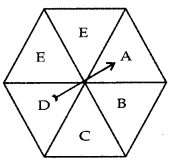
(a) \(\frac{1}{3}\)
(b) \(\frac{1}{2}\)
(c) \(\frac{1}{5}\)
(d) \(\frac{2}{5}\)
Answer:
(b) \(\frac{1}{2}\)
Question 12.
In a bag, there are 100 bulbs out of which 30 are bad ones. A bulb is taken out of the bag at random. The probability of the selected bulb to be good is
(a) 0.50
(b) 0.70
(c) 0.30
(d) none of these
Answer:
(b) 0.70
Question 13.
A game of chance consists of spinning an arrow which comes to rest pointing at one of the numbers. The probability that it will point at number greater than 3 is
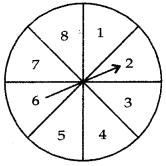
(a) \(\frac{5}{8}\)
(b) \(\frac{3}{4}\)
(c) \(\frac{1}{2}\)
(d) \(\frac{1}{8}\)
Answer:
(a) \(\frac{5}{8}\)
Question 14.
A die is dropped at random on a circular region as shown in adjoining fig. The probability that it will fall on shaded region is
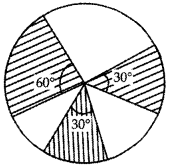
(a) \(\frac{2}{3}\)
(b) \(\frac{1}{4}\)
(c) \(\frac{1}{3}\)
(d) \(\frac{3}{4}\)
Answer:
(c) \(\frac{1}{3}\)
Question 15.
In a class of 30 students, there are 16 girls and 14 boys. Five are A grade students, and three of these students are girls. If a student is chosen at random, the probability of it being a girl student or A grade student is
(a) \(\frac{3}{5}\)
(b) \(\frac{4}{5}\)
(c) \(\frac{8}{15}\)
(d) \(\frac{7}{15}\)
Answer:
(a) \(\frac{3}{5}\)
Fill in the Blanks
Question 1.
An experiment whose outcome can’t be predicted yet it is one of the several possible outcomes is called ___________ experiment.
Answer:
random
Question 2.
Probability of ___________ event is 100%.
Answer:
sure
Question 3.
Probability has two approaches namely ___________ probability and ___________ probability.
Answer:
empirical, theoretical
Question 4.
___________ probability does not require any experiment to be performed.
Answer:
Theoretical
Question 5.
A number is choosen at random from 1 to 9, the probability that it being prime is ___________
Answer:
\(\frac{4}{9}\)
Question 6.
A bag contains 7 red and 7 black balls then the outcomes of getting a red and a black ball are ___________ outcomes.
Answer:
equally likely
Question 7.
Sample space, when two coins are tossed is ___________.
Answer:
{HH, HT, TH, TT}
Question 8.
Event of getting odd number and event of getting even number on die are an example of ___________ events.
Answer:
mutually exclusive
Question 9.
Probability of getting a red card in a single draw from a well shuffled deck of 52 cards ___________.
Answer:
\(\frac{1}{2}\)
Question 10.
Probability of getting a number less than 100 on die is ___________.
Answer:
1
Extra Questions for Class 10 Maths
NCERT Solutions for Class 10 Maths
The post Probability Class 10 Extra Questions Maths Chapter 15 Solutions appeared first on Learn CBSE.
source https://www.learncbse.in/probability-cbse-class-10-maths-chapter-15-extra-questions/
